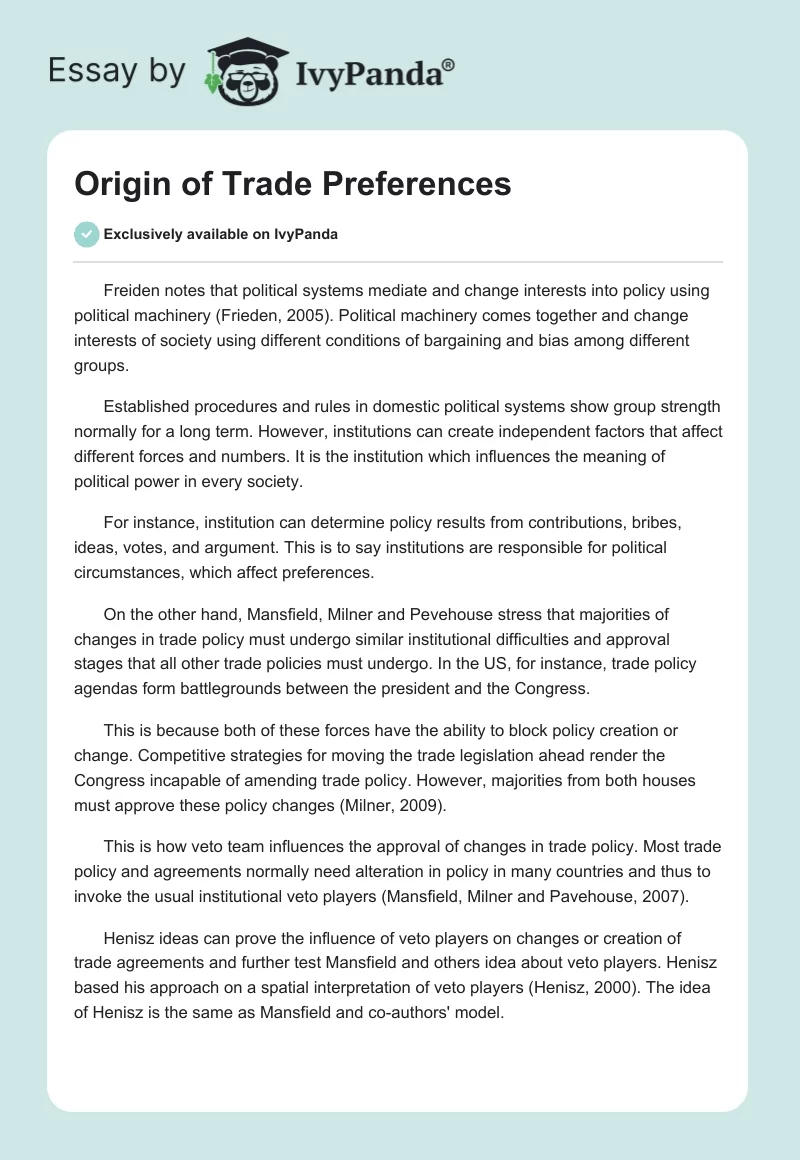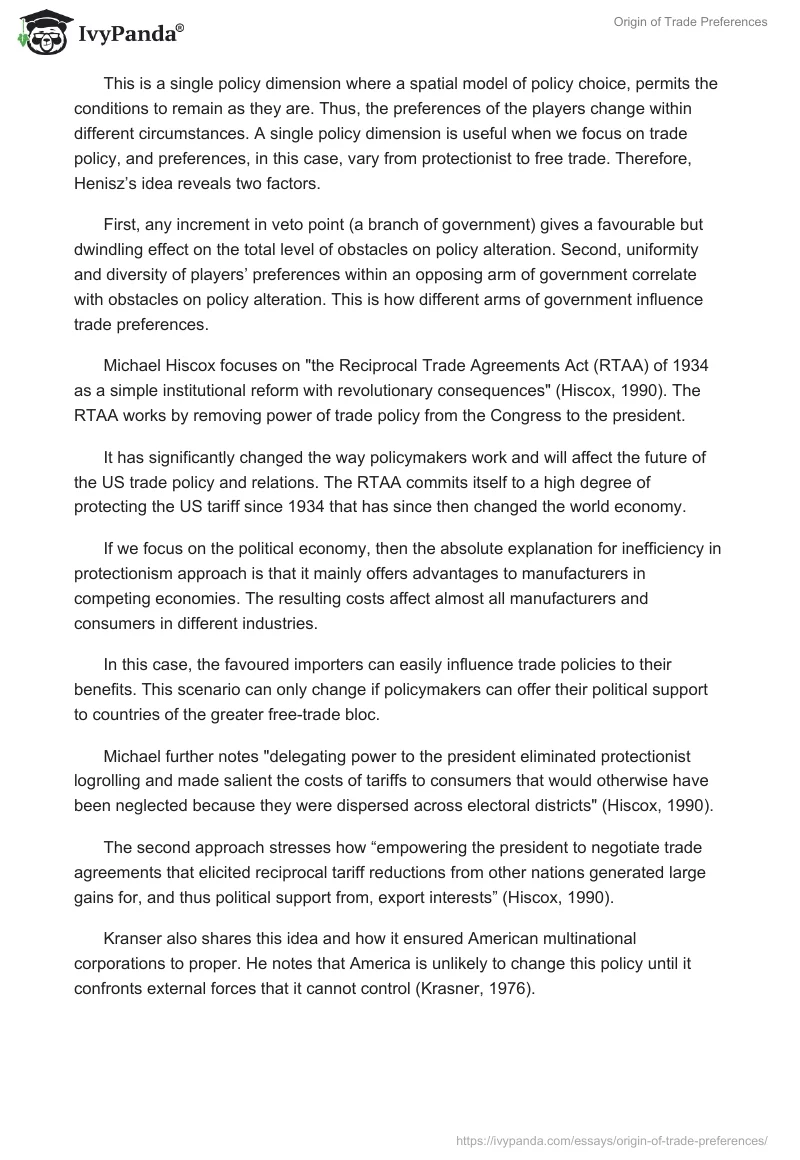Freiden notes that political systems mediate and change interests into policy using political machinery (Frieden, 2005). Political machinery comes together and change interests of society using different conditions of bargaining and bias among different groups.
Established procedures and rules in domestic political systems show group strength normally for a long term. However, institutions can create independent factors that affect different forces and numbers. It is the institution which influences the meaning of political power in every society.
For instance, institution can determine policy results from contributions, bribes, ideas, votes, and argument. This is to say institutions are responsible for political circumstances, which affect preferences.
On the other hand, Mansfield, Milner and Pevehouse stress that majorities of changes in trade policy must undergo similar institutional difficulties and approval stages that all other trade policies must undergo. In the US, for instance, trade policy agendas form battlegrounds between the president and the Congress.
This is because both of these forces have the ability to block policy creation or change. Competitive strategies for moving the trade legislation ahead render the Congress incapable of amending trade policy. However, majorities from both houses must approve these policy changes (Milner, 2009).
This is how veto team influences the approval of changes in trade policy. Most trade policy and agreements normally need alteration in policy in many countries and thus to invoke the usual institutional veto players (Mansfield, Milner and Pavehouse, 2007).
Henisz ideas can prove the influence of veto players on changes or creation of trade agreements and further test Mansfield and others idea about veto players. Henisz based his approach on a spatial interpretation of veto players (Henisz, 2000). The idea of Henisz is the same as Mansfield and co-authors’ model.
This is a single policy dimension where a spatial model of policy choice, permits the conditions to remain as they are. Thus, the preferences of the players change within different circumstances. A single policy dimension is useful when we focus on trade policy, and preferences, in this case, vary from protectionist to free trade. Therefore, Henisz’s idea reveals two factors.
First, any increment in veto point (a branch of government) gives a favourable but dwindling effect on the total level of obstacles on policy alteration. Second, uniformity and diversity of players’ preferences within an opposing arm of government correlate with obstacles on policy alteration. This is how different arms of government influence trade preferences.
Michael Hiscox focuses on “the Reciprocal Trade Agreements Act (RTAA) of 1934 as a simple institutional reform with revolutionary consequences” (Hiscox, 1990). The RTAA works by removing power of trade policy from the Congress to the president.
It has significantly changed the way policymakers work and will affect the future of the US trade policy and relations. The RTAA commits itself to a high degree of protecting the US tariff since 1934 that has since then changed the world economy.
If we focus on the political economy, then the absolute explanation for inefficiency in protectionism approach is that it mainly offers advantages to manufacturers in competing economies. The resulting costs affect almost all manufacturers and consumers in different industries.
In this case, the favoured importers can easily influence trade policies to their benefits. This scenario can only change if policymakers can offer their political support to countries of the greater free-trade bloc.
Michael further notes “delegating power to the president eliminated protectionist logrolling and made salient the costs of tariffs to consumers that would otherwise have been neglected because they were dispersed across electoral districts” (Hiscox, 1990).
The second approach stresses how “empowering the president to negotiate trade agreements that elicited reciprocal tariff reductions from other nations generated large gains for, and thus political support from, export interests” (Hiscox, 1990).
Kranser also shares this idea and how it ensured American multinational corporations to proper. He notes that America is unlikely to change this policy until it confronts external forces that it cannot control (Krasner, 1976).
Goldstein highlights that the US trade laws consist of incoherent policies of protectionist and liberals alike. She argues that the US successful ideas become part of institutions and normally outlast the time during which they served social interests.
She also looks at the past decision of the US government of encouraging high tariffs, and its consequences Goldstein shows the US leaders have advocated both openness and protection agendas in their trade policies since World War II (Goldstein, 2009).
Discuss the theories of individual-level preferences
Scheve and Slaughter show two main results in their analysis of individual-level preferences. These authors highlight that factor type controls labour market in relation to support for trade barriers. Their result is consistent with a Heckscher-Ohlin model of the US.
This model established that the US has highly skilled labour in comparison to the rest of the world. Their result showed that the US has a high intersectoral labour mobility over the time horizons relevant to individuals when evaluating trade policy” (Scheve and Slaughter, 2008).
Scheve and Slaughter note “independent of factor type and homeownership in States with high visibility of industries in comparative disadvantage industries shows a strong correlation with support for trade barriers” (Scheve and Slaughter, 2008). This further shows that apart from the income issues driving preferences like in standard trade model, “there are also asset values that influence preferences” (Scheve and Slaughter, 2008).
In this regard, a trade policy functions like any other policy of the government that have influence on citizens with changes in prices of products. This is how these two factors influence individuals in relations to preferences and various economic policies.
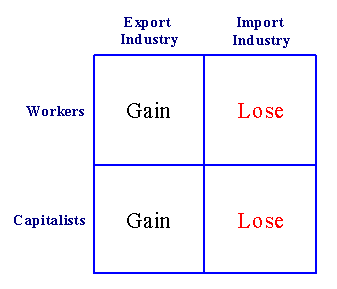
“Since capital is the country’s relatively abundant factor vis-à-vis the rest of the world and labor is its relatively scarce factor, the general conclusion is that a country’s abundant factor gains from trade liberalization while a country’s scarce factor loses.
This result is indicated in the adjoining diagram. Note that capital owners are shown to gain regardless of whether their capital is used in the expanding export sector or the declining import sector. Similarly, all workers lose, even those working in the expanding export sector” (Giancarlo Gandolfo, 1998).
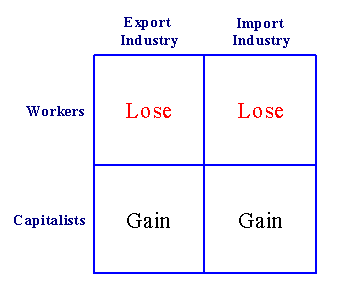
Rogowski developed his theory from that of Stolper-Samuelson in an attempt to understand what happens to local political interests as a result of external forces, risks, or global trade.
Stopler-Samuelson focuses on internal changes in trade barriers by applying comparative advantage to conclude “trade liberalization will benefit abundant factors of production and disadvantage scarce factors in the home economy” (Rogowski, 1987).
Rogowski advances this theory to state “abundant factors of production will advocate for free trade and scarce factors for economic closure” (Rogowski, 1987). He notes that constituents of losers and beneficiaries of free trade lie on two factors, such as land-labour ration and abundance of capital.
Two types of divisions can come from various arrangements of these two factors i.e. class conflict and urban-rural conflict. He argues that the land-labour ratio and degree of capital abundance offer explanation for the diverse responses of countries to the same trade problem as seen in the transportation revolution of the 16th century, 19th century industrialization, the Great Depression, and globalization (Gilpin, 2001).
David Lake developed a theory of hegemonic stability consisting of two different theories. The leadership theory has its roots from public goods and strives to offer an explanation for the international economic infrastructure (Lake, 1993). Lake extends the theory through identification of its essential and adequate conditions, and its implication when leadership may be coercive or benevolent.
The theory of hegemony includes three independent analytic characteristics. It looks at various structures of developed trade policy preferences of countries, and tries to show why there is international economic openness.
Lake theory of leadership and hegemony has some limitations in relations to adequate testing within the existing empirical studies. These theorists have failed to “present their arguments in an appropriate fashion, empiricists have not been sufficiently sensitive to variations in the theory and have produced studies that suffer from inadequate theoretical and operational specification and theoretical over-extension” (Lake, 1993).
At this point, any formal study must aim at strive and provide guidelines for development of this theory.
Frieden observes that earlier theories only aimed at looking at attributes of states, individuals, and systems that generated conflicts. Conversely, the bargain theory of war sees violence as a creation of private information with incentives to misrepresent and problems of credible commitment.
Thus, the bargaining theory of war posits that war occurs as a result of failures in bargaining that only leave both parties worse than if they were to reach an efficient solution.
This is a general theory of violence. However, it is the same to models of strikes and labour unrest and law, particularly with the contests relating to disputes settlement through trial or out-of-court settlement, and other kinds of market failure.
There is also open economy politics theory (OEP) that tries to explain economic policy generation in the international context in which such cases occur. Majorities of theorists try to analyse the international trade policies using local approaches. However, OEP tries to cover both the domestic and international elements of international economic policy creation rigorously.
Studies in the OEP approach start with organisations, industries, or elements of production as the basis of analysis, then deduce their focus on economic policy from each element’s position within the international economy.
These studies also seek to cover the effects of domestic political systems, seeing of systems as methods that control the interaction of competing interests of the society; and they bring bargaining across countries at the international level.
The essential foundation of OEP lies in interests and how certain policies affect individuals or groups. Theories begin with individuals, but it is the organisations, sectors or elements of production that are relevant politically. These scholars derive interests of relevant groups in the international economic policies from current theories.
This enables these theorists to have a strong basis of argument based on their theoretical approaches. OEP defines preferences according to various economic policies and how groups relate to each other in the context of the international economy.
The OEP provides distinctions between international and domestic economics and politics. Organisations differ with regards to activities such as trading or non-trading, importing or exporting -competition, and so on. OEP uses an organisation’s profile to determine how preferences will affect it. Similar characteristics also make sectors vary.
On the other hand, elements of production differ relatively due to scarcity in the world economy. This is how OEP uses these approaches to derive interests in trade policy and analyze international financial and exchange rate, as well as foreign direct investment.
OEP also provides explanations on how nations relate in order to decide on the outcomes of their joint actions when we consider their goals as influenced by systems, and interests. In situations whereby one party has more influence than the other, then the focus shifts to international bargaining.
This requires both states to look at their welfares collectively and decide how to improve them using cooperation. This relates to how international institutions relate to influence the outcomes of the process. The fundamental point to note is that OEP theory looks at both domestic and international economics and politics of nations.
We must look at domestic interests of countries in relations to the global economy and how it affects national policy preferences. This will determine how countries interact in the global scope.
John Keynes provides the theory of liquidity preference in his attempt to analyse what conditions determine the economy’s interest rate. Keynes applies the principles of supply and demand in developing his theory of liquidity preference. According to Keynes, “the interest rate works to changes to balance the supply and demand for money” (Keynes, 1998).
What these theories can and cannot explain about trade policy outcomes
The US government policy to target an interest rate does not basically change analysis of monetary policy. The theory of liquidity preference shows a necessary rule in monetary policy. We can look at monetary policy in two ways i.e., with regard to the money supply or in terms of the interest rate.
This means that when the government declares a point for the interest rate, it devotes itself to changing the supply of money so as to make the equilibrium in the money market hit that point. In other words, the US government can control the behaviour of the market using both the fiscal and monetary policy (Oatley, 2010).
Fiscal policy expresses choice of the government concerning the overall level of the US government purchases or taxes. Government fiscal policy affects individual preferences in terms of investment, growth and savings. At the same time, it also affects the cumulated demand for goods and services. Thus, the theory of liquidity preference shows what the government can do and cannot do in order to influence trade outcomes.
Hiscox notes that none-tariff protectionisms, which do not make any customs income to the government, have become fundamentally necessary after the post-1934 tariff reductions policy. Consequently, new import shares and numbers, mainly in a number of agricultural goods became main defining elements of trade policy after 1934.
In the same year, there was Jones-Costigan Act, which made a provision for quotas on imports of agricultural goods, such as barley, sugar, cotton, wheat, oats, dairy products, rye, and a number of other farm goods. After a number of years, the government introduced quotas on beef, lumber, and potatoes.
This change in policy created an offset of negotiated tariff reductions on Canadian imports. Consequently, there were new quotas on crude oil, cotton, and tobacco in the following policy.
Import Protection in the European Union – selected products
Source: World Trade Organisation
Rogowski makes a valuable observation about the political process as a suspect for an individual-level theory. He notes “those who enjoy a sudden increase in (actual or potential) wealth and income will thereby be enabled to expand their political influence as well” (Rogowski, 1987).
However, this is not an explicit presentation of political processes, but the growth in resources enhances chances of a policy success. In this case, if the success of the policy relies more on will and firms’ ability than resources, then the losing player gets empowerment by the simple fact of losing to the public for political concessions.
However, Rogowski main concern may be cleavages in political success and policy rather than outcomes. On the other hand, he does show that those who lose economically from trade may be winners in the political arena over time. He considers political factors and influences necessary in influencing the outcomes of economic policies.
However, one must note that increase in influence does not necessarily translate to increase in outcomes of a political process. Thus, we may note that what Rogowski is trying to say is that political winners will benefit economically in any political process that may influence an economic policy.
When we take Stopler-Samuelson views, then we may note that Rogowski may have missed the view that there are relatively constant elements in production that create divide based on the industry type instead of general factors. This implies that this situation assumes that changes in the international economy will result into clashes among industries instead of national struggle about abundant and scarce resources of production.
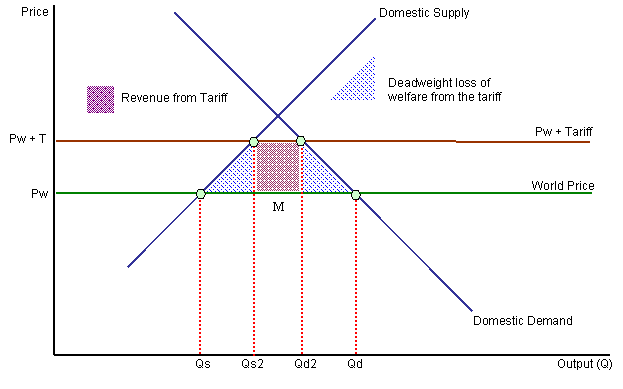
The diagram below shows the welfare consequences of imposing an import tariff.
James Fearon looks at the consequences of failure of bargaining between parties. Conflict is likely to occur if a party has private information that is prone to misinterpretation (Fearon, 2002). In this case, we look at private information as information within the player’s knowledge but with regards to his or her preference, which is usually incomplete information, and this information is not available to the other player.
Any failure and resultant war may mean that an actor may be having incentive not to reveal his private information. However, if this player reveals his private information, then both players may achieve the bargain and the resultant cost of war avoided. The fact is a player will normally misinterpret war plans, which will create bargaining failure.
If the other party has access to private information of the opposing party, then utilities of a war plan become weak. Thus, an opposing party may come up with counter-strategies of neutralising the other party’s plan. Thus, parties may not reveal their private information to each other, and war is likely to occur.
Occasionally, after parties have reached a settlement, they may not commit themselves to the spirit of bargain agreement. This is most likely to create a war. Such failures to fulfil terms of bargain make a settlement lose its credibility. What creates the problem of a commitment is the lack of perfect information.
This is usually when another party is not sure if the opposing side will honour its side of the bargain. Thus, a party may not believe in the future promises of another party. This was the case of the US and Iraq regarding weapons of mass destruction.
Scholars believe that the use of sanction in making policies is disturbing. This is because studies on effects of sanctions reveal that they do not achieve any meaningful gains. Daniels draws a long list of authors who have proved that sanctions rarely work. This observation started after the end of Cold War.
Let us see what Gary Game-theoretic model says about sanctions. He notes that studies tend to focus mainly on failures rather than success of sanctions. The idea is that any sanction results into loss of opportunities for both the imposer and receiver in terms of economic exchange.
This means that the opposing parties can reach an agreement because of the incentive for both before imposing any sanction. However, if the imposing party likes the current state of affairs, then it should not coerce the other party. On the other hand, if the target of the sanction prefers to concede in order to avoid the costs of sanction, then it has a valid reason to agree before the sender imposes a sanction against her (Drezner, 2003).
Reference List
Drezner, D 2003, ‘The Hidden Hand of Economic Coercion’, International Relations, vol. 7, pp. 45-50.
Fearon, J 2002, ‘Primary Commodity Exports and Civil War’, International Economics, vol.3, pp. 130-134.
Frieden, J 2005, ‘International Relations as a Social Science’, Rigor and Relevance, vol. 1, pp. 5-6.
Gilpin, R 2001, Global Political Economy: Understanding the International Economic Order, Cambridge University Press, Cambridge.
Goldstein, J 2009, ‘Ideas, institutions, and American trade policy’, American Trade Policy, vol. 3, pp. 22-25.
Henisz, W 2000, ‘Vetoing Co-operation: The Impact of Veto Players on Economy’, Cambridge Journals, vol. 1, pp. 34-40.
Hiscox, M 1990 ‘The RTAA, Institutional Reform, and Trade Liberalization’, The Magic Bullet, vol. 1, pp. 10-11.
Keynes, J 1998, The General Theory of Employment, Interest And Money, John Wiley, New York.
Krasner, S 1976, ‘State Power and the Structure of International Trade’, International Trade, vol. 2, pp. 1-2.
Lake, D 1993, ‘Naked Emperor or Tattered Monarch with Potential? Leadership, Hegemony, and the International Economy, vol. 12, pp. 3-4.
Mansfield, E, Milner, H and Pavehouse, J 2007, ‘The Impact of Veto Players on Preferential Trading Arrangements’, Vetoing Co-operation, vol. 1, pp. 6-7.
Milner, H 2009, ‘Resisting the protectionist temptation: industry and the making of trade policy in France and the United States during the 1970s’, Economics, vol. 5, pp. 22-24.
Oatley, T 2010, International political economy: interests and institutions in the global economy, Longman, London.
Rogowski, R 1987, ‘Political Cleavages and Changing Exposure to Trade’, International Trade, vol. 2 , pp. 1-3.
Scheve, K and Slaughter, M 2008, ‘What determines individual trade-policy preferences?’, Trade-Policy Preferences, vol. 1, pp. 1-3.

